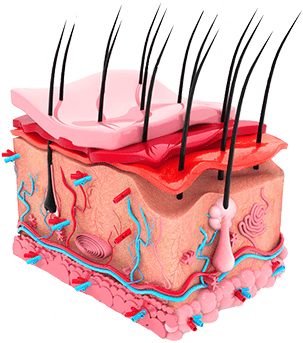DNA test for genetic predisposition to hair loss
Hair loss (alopecia) — is a widespread problem affecting mainly middle-aged men. If there is a hereditary burden, the first signs of hair loss may appear much earlier, at the age of 30, 25 or even 20.
by e-mail (anytime):
 EN | USD
EN | USD
by e-mail (anytime):
Hair loss (alopecia) — is a widespread problem affecting mainly middle-aged men. If there is a hereditary burden, the first signs of hair loss may appear much earlier, at the age of 30, 25 or even 20.


is not a stand-alone condition, but a complex of symptoms whose characteristic feature is pathological hair loss. The intensity of the pathological process and the size of the areas it strikes may vary according to the causes of hair loss.
All forms of hair loss fall into one of four main groups:
Scar alopecia is not amenable to conservative treatment, because the connective tissue of a scar contains no hair follicles. In the treatment of symptomatic alopecia, it is essential to remove the fundamental causes of the underlying illness (endocrine disorders, the effects of stress, an unbalanced diet or the use of toxic pharmaceuticals).Androgenetic alopecia and spot baldness are standalone conditions with particular development mechanisms and specific symptoms; we shall therefore examine these in more detail.
Statistics show that androgenetic alopecia is the cause of 94–97% of cases of hair loss in men. The very name of the condition points to the clear link between hair loss and androgens – male sex hormones. It has long been known that castration halts the hair loss process in men in absolutely all cases, while androgen intake (as replacement therapy, for example) causes it to resume.
Alopecia is not purely a male problem, however. Around 60% of women over 40 complain of increased hair loss and thinning of the hair on the head, and the presence of a problem is confirmed by a trichologist in 30% of cases. Hair loss in women is of course far less pronounced than in men, because of the significantly lower level of male sex hormones in their bodies. Still, it is women who most often visit hair loss specialists.
The development mechanism of androgenic alopecia is associated with the hormone dihydrotestosterone (DHT), which is synthesized from testosterone. An excess of DHT causes the hair follicles on the scalp to be suppressed, while those in the chin and cheek area are activated. This is what causes beard and mustache growth in men, as well as their usually rather thin head hair – in contract to women, who are far more likely to have abundant coiffures.
The fact that androgenetic hair loss depends on DHT levels does not at all imply a direct relationship between the two. For example, an absolute majority of women with this type of alopecia have normal levels of testosterone and DHT. Hair loss results from the effect of unfavorable factors.
Trichologists believe that a genetic predisposition is the main cause of androgenetic hair loss, and the other risk factors are merely minor associated considerations. A hereditary predisposition to alopecia may be expressed in one of two main ways:
Heightened sensitivity of the follicles to dihydrotestosterone;
Elevated secretion or excessive activity of the enzyme responsible for converting testosterone into DHT.
Quite recently, it was thought that a predisposition to hair loss was transmitted only down the maternal line: in 2005, scientists detected a so-called "baldness gene" on the female X chromosome. However, several other genes coding for androgenic alopecia, but passed on along both the female and the male line, were soon identified.
Unlike the other forms of alopecia, androgenic hair loss is characterized by the following signs:
When androgenetic alopecia occurs in women, hair loss begins at the crown and is diffuse. Hardly any pronounced bald patches are formed; a thinning of the hair on the head is observed. Associated signs frequently include patches of acne on the face and back, increased greasiness of the skin on the face and head, occurrences of seborrhea, and excessive male-pattern hair growth on the body.
To confirm the diagnosis, the doctor may order an analysis of the levels of male sex hormones in the blood, and a microscopic examination to assess the condition of the hair follicles. A hormonal status test allows identification of severe endocrine disorders requiring medical intervention.
Where symptomatic alopecia is suspected, the specialist will recommend a more thorough examination, possibly including laboratory tests, an ultrasound scan, x-ray examination etc.
People are looking for hair loss cures all the time, but this is all but impossible in the later stages.
Don't leave it till the last minute! Take a DNA test for genetic predisposition to hair loss - do something about keeping your hair while there's time.

In order to prescribe an effective therapy, it is important to identify the type of hair loss, as this will determine the selection of an appropriate course of treatment. In any event, the patient should prepare for a prolonged effort with gradual, and sometimes not very evident, improvement.
The treatment of androgenetic hair loss uses:
Minoxidil is prescribed for local use. When rubbed into the scalp, it dilates the blood vessels supplying the follicles and prolongs the hair's active growth phase. Despite its apparently universal action, minoxidil has proven effective only in the treatment of androgenetic hair loss.
Finasteride, an effective preparation with a specific effect, blocks the action of the enzyme that converts testosterone into DHT. The reduction in levels of this hormone prolongs the growth phase of hair sensitive to DHT; the strands become fatter and the hair thicker. This preparation is only used to treat hair loss in men.
Important: like any preparation that adjusts the hormonal background, finasteride must not be used unless recommended by a specialist or without professional supervision of the therapy. Possible side effects of the treatment include libidinal and potency dysfunction, gynecomastia, and allergic reactions.
The treatment of androgenetic alopecia in women may include prolonged administration of the hormonal contraceptive Diane 35. The expected effects are increased hair growth on the head, reduced rate of hair loss, and a reduction in the associated signs of virilization – a healing of acne and a reduction in hair growth on the arms, legs, tummy and face.
Low-intensity laser therapy is another treatment method that is quite effective. Its main drawback is the instability of the results: hard can begin to fall out again almost immediately after the treatment ends.
Supplementary treatment methods include massage, electrostimulation, electrophoresis and phytotherapy. All these have insignificant effect, but they may consolidate and reinforce the action of the main therapeutic approaches.
Hair transplantation is carried out at specialized clinics. The patient's own hair follicles are taken for transplantation from areas with intact hair (the back of the head or the temples). When the outcome is favorable, the follicles take root and can remain fully functioning for life.
Alopecia Areata (spot baldness) is a fairly rare form of the illness that occurs through a completely different mechanism. In this type of alopecia, scientists associate the loss of hair with autoimmune mechanisms where the antibodies destroy the body's own tissues.
The true cause of the disease has not yet been established, but scientists have identified the main risk factors for alopecia areata:
As with androgenetic alopecia, alopecia areata is most often reliably identified in people with a genetic predisposition. It has been established that, if close relatives have had this form of the illness, the risk of alopecia areata is significantly increased. Thus, the decisive factor is genetic predisposition, while an unfavorable external impact is merely a "launch mechanism".
Despite the frequent cases of spontaneous hair regrowth in alopecia areata, treatment helps speed up the process significantly. To make therapy more effective, specialists recommend combining several treatment methods.
The following are prescribed for alopecia areata:
Any drug treatments are prescribed only by a doctor following examination and identification of indications and contraindications.
The range of preventive measures against hair loss is based on a healthy way of life and correct hair care. It is important to pay careful attention to the leading risk factor for androgenetic alopecia and alopecia areata, namely hereditary predisposition. Of course, no one can eliminate the effect of this factor, but it is always possible to start prevention early.
A DNA test for a genetic predisposition to hair loss is a highly informative approach to identifying one's risk of the disease. The result of the test will help your treating physician select an effective individual alopecia prevention strategy.
Keep your hair abundant and healthy: start hair loss prevention as early as you can.
